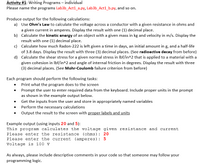
Computer Networking: A Top-Down Approach (7th Edition)
7th Edition
ISBN: 9780133594140
Author: James Kurose, Keith Ross
Publisher: PEARSON
expand_more
expand_more
format_list_bulleted
Question
thumb_up100%
Please help me code part D of this question in python

Transcribed Image Text:Activity #1: Writing Programs – individual
Please name the programs Lab3b_Act1_a.py, Lab3b_Act1_b.py, and so on.
Produce output for the following calculations:
a) Use Ohm's Law to calculate the voltage across a conductor with a given resistance in ohms and
a given current in amperes. Display the result with one (1) decimal place.
b) Calculate the kinetic energy of an object with a given mass in kg and velocity in m/s. Display the
result with one (1) decimal place.
c) Calculate how much Radon-222 is left given a time in days, an initial amount in g, and a half-life
of 3.8 days. Display the result with three (3) decimal places. (See radioactive decay from before)
d) Calculate the shear stress for a given normal stress in Ibf/in^2 that is applied to a material with a
given cohesion in Ibf/in^2 and angle of internal friction in degrees. Display the result with three
(3) decimal places. (See Mohr-Coulomb failure criterion from before)
Each program should perform the following tasks:
Print what the program does to the screen
Prompt the user to enter required data from the keyboard. Include proper units in the prompt
as shown in the example output below.
Get the inputs from the user and store in appropriately named variables
Perform the necessary calculations
Output the result to the screen with proper labels and units
Example output (using inputs 20 and 5):
This program calculates the voltage given resistance and current
Please enter the resistance (ohms) : 20
Please enter the current (amperes): 5
Voltage is 100 v
As always, please include descriptive comments in your code so that someone may follow your
programming logic.
Expert Solution
arrow_forward
Program Explanation
- Define module math for math operations.
- Define function res.
- Define variable coh and take user input for cohesion under it.
- Define variable stress and take user input for the same and store under it.
- Define variable ang and take user input for internal friction angle and store under it.
- Define variable sh_str and calculate the result and store in this.
- Print the result.
- Call function res.
Step by stepSolved in 3 steps with 1 images

Knowledge Booster
Similar questions
- Various design methods are used to increase readability of the code.arrow_forwardPlease provide a list of the top six reasons why it's useful to understand how compilers work.arrow_forwardA list of any three programming languages that are often utilised in the development of web-based applications should be provided.arrow_forward
- Python code not working, please check my code. Here is the question it is based off: Building and using DNA Motifs Background Sequence motifs are short, recurring (meaning conserved) patterns in DNA that are presumed to have a biological function. Often they indicate sequence-specific binding sites for proteins and other important markers. However, sometimes they are not exactly conserved, meaning some mutations can happen in a motif in a particular organism. Mutations can be DNA substitutions/deletions/insertions. Therefore, sequences are usually aligned and a consensus pattern of a motif is calculated over all examples from organisms. The following are examples of a transcription factor binding (TFB) site for the lexA repressor in_ E. Coli _located in a file called lexA.fasta: >dinD 32->52 aactgtatataaatacagtt >dinG 15->35 tattggctgtttatacagta >dinH 77->97 tcctgttaatccatacagca >dinI 19->39 acctgtataaataaccagta >lexA-1 28->48 tgctgtatatactcacagca…arrow_forward"Programming style"—what comes to mind? Please comment. Is there a standard programming style?arrow_forwardIn the context of computer programming, what does it mean to "resist the urge to code"?arrow_forward
arrow_back_ios
arrow_forward_ios
Recommended textbooks for you
 Computer Networking: A Top-Down Approach (7th Edi...Computer EngineeringISBN:9780133594140Author:James Kurose, Keith RossPublisher:PEARSON
Computer Networking: A Top-Down Approach (7th Edi...Computer EngineeringISBN:9780133594140Author:James Kurose, Keith RossPublisher:PEARSON Computer Organization and Design MIPS Edition, Fi...Computer EngineeringISBN:9780124077263Author:David A. Patterson, John L. HennessyPublisher:Elsevier Science
Computer Organization and Design MIPS Edition, Fi...Computer EngineeringISBN:9780124077263Author:David A. Patterson, John L. HennessyPublisher:Elsevier Science Network+ Guide to Networks (MindTap Course List)Computer EngineeringISBN:9781337569330Author:Jill West, Tamara Dean, Jean AndrewsPublisher:Cengage Learning
Network+ Guide to Networks (MindTap Course List)Computer EngineeringISBN:9781337569330Author:Jill West, Tamara Dean, Jean AndrewsPublisher:Cengage Learning Concepts of Database ManagementComputer EngineeringISBN:9781337093422Author:Joy L. Starks, Philip J. Pratt, Mary Z. LastPublisher:Cengage Learning
Concepts of Database ManagementComputer EngineeringISBN:9781337093422Author:Joy L. Starks, Philip J. Pratt, Mary Z. LastPublisher:Cengage Learning Prelude to ProgrammingComputer EngineeringISBN:9780133750423Author:VENIT, StewartPublisher:Pearson Education
Prelude to ProgrammingComputer EngineeringISBN:9780133750423Author:VENIT, StewartPublisher:Pearson Education Sc Business Data Communications and Networking, T...Computer EngineeringISBN:9781119368830Author:FITZGERALDPublisher:WILEY
Sc Business Data Communications and Networking, T...Computer EngineeringISBN:9781119368830Author:FITZGERALDPublisher:WILEY

Computer Networking: A Top-Down Approach (7th Edi...
Computer Engineering
ISBN:9780133594140
Author:James Kurose, Keith Ross
Publisher:PEARSON

Computer Organization and Design MIPS Edition, Fi...
Computer Engineering
ISBN:9780124077263
Author:David A. Patterson, John L. Hennessy
Publisher:Elsevier Science

Network+ Guide to Networks (MindTap Course List)
Computer Engineering
ISBN:9781337569330
Author:Jill West, Tamara Dean, Jean Andrews
Publisher:Cengage Learning

Concepts of Database Management
Computer Engineering
ISBN:9781337093422
Author:Joy L. Starks, Philip J. Pratt, Mary Z. Last
Publisher:Cengage Learning

Prelude to Programming
Computer Engineering
ISBN:9780133750423
Author:VENIT, Stewart
Publisher:Pearson Education

Sc Business Data Communications and Networking, T...
Computer Engineering
ISBN:9781119368830
Author:FITZGERALD
Publisher:WILEY